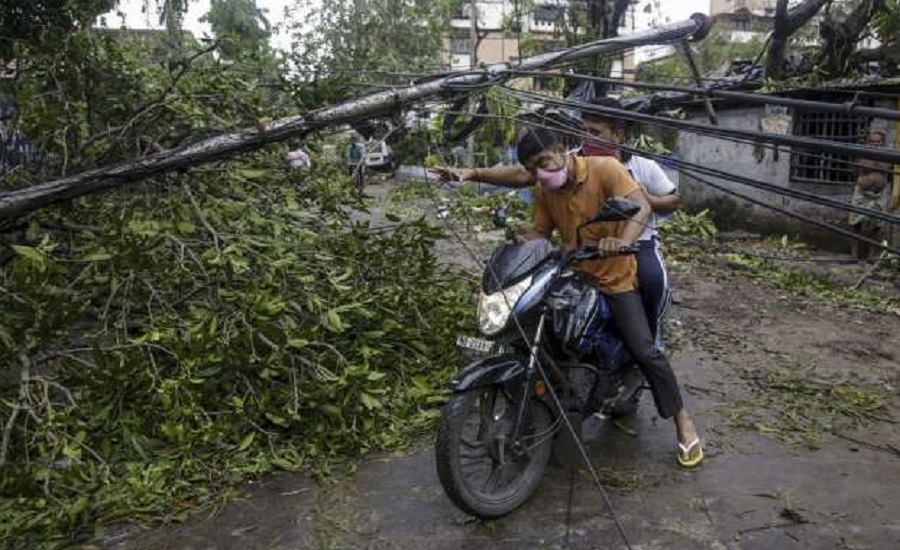Cyclone kills at least 82 in India, Bangladesh, causes widespread flooding

People make their way through damaged cables and a tree branch fallen in the middle of a road after Cyclone Amphan hit the region in Kolkata, India, Thursday, May 21, 2020. A powerful cyclone ripped through densely populated coastal India and Bangladesh, blowing off roofs and whipping up waves that swallowed embankments and bridges and left entire villages without access to fresh water, electricity and communications. (AP Photo/Bikas Das)
KOLKATA/DHAKA|2020-05-22 Friday(Reuters)
The most powerful cyclone to strike eastern India and Bangladesh in over a decade killed at least 82 people, officials said, as rescue teams scoured devastated coastal villages, hampered by torn down power lines and flooding over large tracts of land.
Mass evacuations organised by authorities before Cyclone Amphan made landfall undoubtedly saved countless lives, but the full extent of the casualties and damage to property would only be known once communications were restored, officials said.
In the Indian state of West Bengal, Chief Minister Mamata Banerjee said on Thursday that at least 72 people had perished – most of them either electrocuted or killed by trees uprooted by winds that gusted up to 185 km per hour (115 mph).
In neighbouring Bangladesh, the initial toll was put at 10.
“I have never seen such a cyclone in my life. It seemed like the end of the world. All I could do was to pray… Almighty Allah saved us,” Azgar Ali, 49, a resident of Satkhira district on the Bangladesh coast told Reuters.
Mohammad Asaduzzaman, a senior police official in the area said the storm tore off tin roofs, snapped power lines and left many villages inundated.
When the cyclone barrelled in from the Bay of Bengal on Wednesday the storm surge of around five metres resulted in flooding across the low-lying coastal areas.
Reuters Television footage shot in West Bengal showed upturned boats on the shore, people wading through knee-deep water and buses crashed into each other. More images showed villagers trying to lift fallen electricity poles, fishermen hauling their boats out of a choppy sea, and uprooted trees lying strewn across the countryside.
Designated a super cyclone, Amphan has weakened since making landfall. Moving inland through Bangladesh, it was downgraded to a cyclonic storm on Thursday by the Indian weather office. And the storm was expected to subside into a depression later.
Indian Prime Minister Narendra Modi posted a tweet expressing concern over the people suffering in West Bengal.
“Have been seeing visuals from West Bengal on the devastation caused by Cyclone Amphan. In this challenging hour, the entire nation stands in solidarity with West Bengal,” he said.
Concern was growing over flooding in the Sundarbans, an ecologically-fragile region straddling the Indian-Bangladesh border, best known for thick mangrove forests and its tiger reserve.
“The tidal surge submerged some part of the forest,” said Belayet Hossain, a forest official on the Bangladesh side of the forest. “We have seen trees uprooted, the tin-roofs of the guard towers blown off,” he said.
Over on the Indian side of the Sundarbans, a village official said embankments surrounding a low-lying island, where some 5,000 people live, had been washed away, and he had been unable to contact authorities for help.
“We have not been able inform them about anything since last night, the official, Sanjib Sagar, told Reuters.










